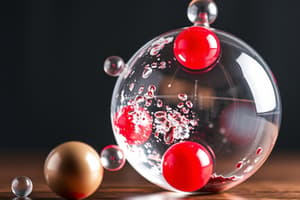Podcast
Questions and Answers
What is the primary form in which oxygen is transported in blood?
What is the primary form in which oxygen is transported in blood?
- As dissolved gas in plasma
- In free form as diatomic oxygen
- Complexed with carrier proteins such as hemoglobin (correct)
- As carbon dioxide
What is the significance of Dalton's law in relation to gases?
What is the significance of Dalton's law in relation to gases?
- It outlines the method for measuring blood oxygen levels.
- It states that gases can only exist in a gas phase.
- It defines the behavior of gases at low temperatures.
- It describes how each gas in a mixture exerts a pressure proportional to its concentration. (correct)
At sea level, what is the partial pressure of oxygen in mm Hg?
At sea level, what is the partial pressure of oxygen in mm Hg?
- 200 mm Hg
- 620 mm Hg
- 97.4 mm Hg
- ~160 mm Hg (correct)
What is the total oxygen-carrying capacity of arterial blood, combining dissolved and protein-bound forms?
What is the total oxygen-carrying capacity of arterial blood, combining dissolved and protein-bound forms?
Why is the level of dissolved oxygen in arterial blood considered inadequate for aerobic metabolism?
Why is the level of dissolved oxygen in arterial blood considered inadequate for aerobic metabolism?
Flashcards are hidden until you start studying
Study Notes
Properties of Oxygen
- Most oxygen in the body is bound to heme-containing carrier proteins: myoglobin (Mb) and hemoglobin (Hb).
- Photosynthetic organisms contribute to Earth's atmospheric oxygen by releasing diatomic oxygen, maintaining a current level of 21% in the air.
- Dalton's law explains that in gas mixtures, each gas contributes to a specific partial pressure directly proportional to its concentration.
- The partial pressure of a gas is commonly used to measure its concentration in physiological fluids.
- At sea level (760 mm Hg), the partial pressure of oxygen (Po2) is approximately 160 mm Hg (21% of total pressure).
- The amount of O2 dissolved in solution is proportional to its partial pressure; Po2 in arterial blood (37°C, pH 7.4) is 100 mm Hg, yielding a concentration of 0.13 mmol/L.
- This dissolved O2 concentration of 0.13 mmol/L is insufficient for efficient aerobic metabolism.
- Most oxygen transport in blood and muscle storage is facilitated by hemoglobin and myoglobin, complexed with ferrous iron (Fe2+).
- Hemoglobin is a tetrameric protein with four heme groups, allowing it to bind four molecules of O2.
- In arterial blood, with Hb concentration at 150 g/L (2.3 mmol/L) and O2 saturation at 97.4%, the protein-bound O2 concentration is about 8.7 mmol/L.
- Protein-bound O2 concentration represents a significant 67-fold increase compared to dissolved O2.
- The total oxygen-carrying capacity of arterial blood, combining dissolved and protein-bound forms, reaches 8.8 mmol/L, equating to nearly 200 mL of dissolved oxygen per liter of blood.
Studying That Suits You
Use AI to generate personalized quizzes and flashcards to suit your learning preferences.




